Max Planck Institute for Radio Astronomy (MPIfR) | Netherlands Institute for Radio Astronomy (ASTRON) | 2019 Feb 19
Astronomers publish new sky map detecting a vast number of previously unknown galaxies
An international team of more than 200 astronomers from 18 countries including scientists from the Max Planck Institute for Radio Astronomy in Bonn, Germany, has published the first phase of a major new radio sky survey at unprecedented sensitivity using the Low Frequency Array (LOFAR) telescope. The survey reveals hundreds of thousands of previously undetected galaxies, shedding new light on many research areas including the physics of black holes and how clusters of galaxies evolve.
- Galaxy cluster Abell 1314 in the constellation „Ursa Major“ in a distance of approximately 460 million light years. The LOFAR observations reveal radio emission from high-speed cosmic electrons (marked in red) resulting from collisions with other galaxy clusters. The overlay onto an optical image also shows hot X-ray gas (marked in grey) from observations with the Chandra satellite. (Credit: Amanda Wilber/LOFAR Surveys Team)
A special issue of the scientific journal Astronomy & Astrophysics is dedicated to the first twenty-six research papers describing the survey and its first results.
Radio astronomy reveals processes in the Universe that we cannot see with optical instruments. In this first part of the sky survey, LOFAR observed a quarter of the northern hemisphere at low radio frequencies. At this point, approximately ten percent of that data is now made public. It maps three hundred thousand sources, almost all of which are galaxies in the distant Universe; their radio signals have travelled billions of light years before reaching Earth. ...
The 26 research papers in the special issue of Astronomy & Astrophysics were done with only the first two percent of the sky survey. The team aims to make sensitive high-resolution images of the whole northern sky, which will reveal 15 million radio sources in total. “Just imagine some of the discoveries we may make along the way. I certainly look forward to it”, says Jackson. “And among these there will be the first massive black holes that formed when the Universe was only a ‘baby’, with an age a few percent of its present age”, adds Röttgering.
The LOFAR Two-metre Sky Survey II. First data release ~ T. W. Shimwell et al
- Astronomy & Astrophysics 622:A1 (2019 Feb) DOI: 10.1051/0004-6361/201833559
- arXiv.org > astro-ph > arXiv:1811.07926 > 19 Nov 2018
- Astronomy & Astrophysics 622:A2 (2019 Feb) DOI: 10.1051/0004-6361/201833564
- arXiv.org > astro-ph > arXiv:1811.07927 > 19 Nov 2018
- Astronomy & Astrophysics 622:A3 (2019 Feb) DOI: 10.1051/0004-6361/201833562
- arXiv.org > astro-ph > arXiv:1811.07928 > 19 Nov 2018
- Astronomy & Astrophysics 622:A4 (2019 Feb) DOI: 10.1051/0004-6361/201833906
- arXiv.org > astro-ph > arXiv:1811.07942 > 19 Nov 2018
- Astronomy & Astrophysics 622:A5 (2019 Feb) DOI: 10.1051/0004-6361/201833867
- arXiv.org > astro-ph > arXiv:1811.07954 > 19 Nov 2018
- Astronomy & Astrophysics 622:A6 (2019 Feb) DOI: 10.1051/0004-6361/201833865
- arXiv.org > astro-ph > arXiv:1810.07584 > 17 Oct 2018
- Astronomy & Astrophysics 622:A7 (2019 Feb) DOI: 10.1051/0004-6361/201834052
- arXiv.org > astro-ph > arXiv:1811.08104 > 20 Nov 2018
- Astronomy & Astrophysics 622:A8 (2019 Feb) DOI: 10.1051/0004-6361/201833905
- arXiv.org > astro-ph > arXiv:1811.07968 > 19 Nov 2018
- Astronomy & Astrophysics 622:A9 (2019 Feb) DOI: 10.1051/0004-6361/201833931
- arXiv.org > astro-ph > arXiv:1811.04015 > 09 Nov 2018 (v1), 21 Nov 2018 (v2)
- Astronomy & Astrophysics 622:A10 (2019 Feb) DOI: 10.1051/0004-6361/201834019
- arXiv.org > astro-ph > arXiv:1811.07949 > 19 Nov 2018
- Astronomy & Astrophysics 622:A11 (2019 Feb) DOI: 10.1051/0004-6361/201833892
- arXiv.org > astro-ph > arXiv:1811.07933 > 19 Nov 2018
- Astronomy & Astrophysics 622:A12 (2019 Feb) DOI: 10.1051/0004-6361/201833893
- arXiv.org > astro-ph > arXiv:1811.07943 > 19 Nov 2018
- Astronomy & Astrophysics 622:A13 (2019 Feb) DOI: 10.1051/0004-6361/201833973
- arXiv.org > astro-ph > arXiv:1811.08194 > 20 Nov 2018
- Astronomy & Astrophysics 622:A14 (2019 Feb) DOI: 10.1051/0004-6361/201833937
- arXiv.org > astro-ph > arXiv:1811.07961 > 19 Nov 2018
- Astronomy & Astrophysics 622:A15 (2019 Feb) DOI: 10.1051/0004-6361/201833821
- arXiv.org > astro-ph > arXiv:1811.07931 > 19 Nov 2018
- Astronomy & Astrophysics 622:A16 (2019 Feb) DOI: 10.1051/0004-6361/201833832
- arXiv.org > astro-ph > arXiv:1811.07934 > 19 Nov 2018
- Astronomy & Astrophysics 622:A17 (2019 Feb) DOI: 10.1051/0004-6361/201833883
- arXiv.org > astro-ph > arXiv:1811.05528 > 13 Nov 2018 (v1), 19 Nov 2018 (v2)
- Astronomy & Astrophysics 622:A18 (2019 Feb) DOI: 10.1051/0004-6361/201833967
- arXiv.org > astro-ph > arXiv:1811.07932 > 19 Nov 2018
- Astronomy & Astrophysics 622:A19 (2019 Feb) DOI: 10.1051/0004-6361/201833861
- arXiv.org > astro-ph > arXiv:1811.07930 > 19 Nov 2018
- Astronomy & Astrophysics 622:A20 (2019 Feb) DOI: 10.1051/0004-6361/201833900
- arXiv.org > astro-ph > arXiv:1811.09713 > 19 Nov 2018
- Astronomy & Astrophysics 622:A21 (2019 Feb) DOI: 10.1051/0004-6361/201834025
- arXiv.org > astro-ph > arXiv:1811.09708 > 19 Nov 2018
- Astronomy & Astrophysics 622:A22 (2019 Feb) DOI: 10.1051/0004-6361/201833992
- arXiv.org > astro-ph > arXiv:1811.08430 > 20 Nov 2018
of compact galaxy groups using the LOFAR Two-Metre Sky Survey (LoTSS) ~ B. Nikiel-Wroczyński et al
- Astronomy & Astrophysics 622:A23 (2019 Feb) DOI: 10.1051/0004-6361/201833934
- arXiv.org > astro-ph > arXiv:1810.08708 > 19 Oct 2018 (v1), 20 Nov 2018 (v3)
- Astronomy & Astrophysics 622:A24 (2019 Feb) DOI: 10.1051/0004-6361/201833882
- arXiv.org > astro-ph > arXiv:1811.08410 > 20 Nov 2018
- Astronomy & Astrophysics 622:A25 (2019 Feb) DOI: 10.1051/0004-6361/201833884
- arXiv.org > astro-ph > arXiv:1811.07929 > 19 Nov 2018
